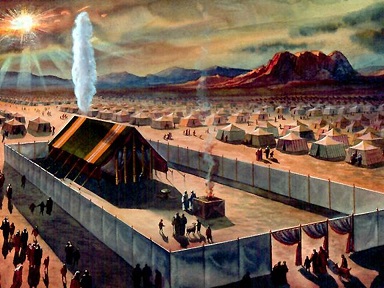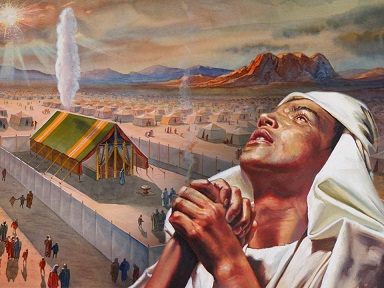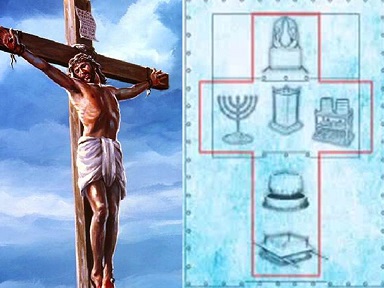
The Architecture of the Sanctuary

Samuel Smith
23 Jan'19
5
LESSON 1
THE ARCHITECTURE OF THE SANCTUARY
You are welcome to another edition of Insights from God's Word, a Bible study programme that is committed to sharing God's Word by allowing the Bible to speak for itself.In this edition, we continue with our series on His Way is in the Sanctuary. The topic for this study is: The Architecture of the Sanctuary. When God led the Israelites through the wilderness, He commanded Moses to build Him a sanctuary so He will dwell among them (
1) A SUMMARY DESCRIPTION OF THE SANCTUARY
The sanctuary was a sacred tent that could be moved from one place to the other as Israel journeyed to the Promised Land of Canaan. The sanctuary was made up of the courtyard and the tabernacle. The courtyard was the open area around the tabernacle and measured 150 feet long, 75 feet wide, and 7.5 feet high (seeThe walls were made of fine twined linen (white) and enclosed the entire sanctuary (see
2) THE ARTICLES OF FURNITURE IN THE SANCTUARY
There were six articles of furniture within the sanctuary. Two were located at the court, three were located at the Holy Place, and one was located at the Most Holy place.A) ARTICLES OF FURNITURE AT THE COURT
The two articles of furniture at the court were the altar of sacrifice and the laver.
i) The Altar of Sacrifice: This was the first article of furniture one encountered at the court. The altar was made of wood and covered with brass. It was shaped into a perfect square with horns on each of the four corners. It was about 7.5 feet square and 4.5 feet high. At the altar of sacrifice, both animals and grain were offered as sacrificial offerings to the Lord (see
ii) The Laver: This was the second article of furniture one encountered at the court. It came after the altar of sacrifice and before the entrance to the tabernacle. It was a washing basin made of solid bronze and set on a bronze stand. The laver was filled with water for the priests to wash their hands and feet before they could minster at the brazen altar or enter the tabernacle to serve. No dimensions of the laver are given in Scripture (see
B) ARTICLES OF FURNITURE AT THE HOLY PLACE
The three articles of furniture at the Holy Place were the table of showbread, the golden candlestick and the altar of incense.
i) The Table of Showbread: This furniture was made of acacia wood and covered with gold. It measured 3 feet long, 1.5 feet wide and 2.25 feet high. This table was located on the north side of the Holy Place and was directly opposite the golden candlestick. 12 loaves of unleavened bread (separated into 2 rows of six) were placed on the table continually before the Lord by the priests. The twelve loaves of bread represented the 12 tribes of Israel. It is likely that offerings of wine were also placed on the table of showbread (see
ii) The Golden Candlestick (Menorah): This furniture was made of gold and formed into the shape of an almond tree. This candlestick was located on the south part of the Holy Place, and was directly opposite the table of showbread. The menorah had six branches with a central shaft or trunk. Thus, it is usually referred to as the seven-branched candlestick. The menorah used pure olive oil as fuel. Each morning and evening, the high priest trimmed the wicks and supplied the needed oil so the menorah will provide a constant source of light at the holy place. No dimensions of the menorah are given in Scripture (see
iii) The Altar of Incense: This furniture was made of acacia wood and covered with gold. The altar of incense was 1.5 feet square and about 3 feet high with horns on each corner. This altar was located at the west side of the Holy Place, immediately before the veil which separated the Holy Place from the Most Holy Place. This altar contained a brass pot with hot coals from the brazen altar of sacrifice. On this altar, the priests burned a special incense that generated a sweet smelling fragrance before the Lord in the Most Holy Place (see
iv) The Veil: Even though this was not an article of furniture, it had great significance as far as the temple services were concerned. The veil separated the Holy Place from the Most Holy Place of the tabernacle, and covered the Shekina glory of God. Thus, one had to pass through the veil to enter the Most Holy Place of the sanctuary. The veil was made of blue, purple and scarlet yarn and finely twisted linen, with cherubim woven into it by a skilled worker. Every priest could work at the court and Holy Place of the sanctuary. However, it was only the high priest who could enter through the veil into the Most Holy Place of the tabernacle once in a year (see
C) ARTICLE OF FURNITURE AT THE MOST HOLY PLACE
The only article of furniture at the Most Holy Place was the Ark of the Covenant. The ark was a box constructed with acacia wood and covered with gold. It was 3.75 feet long, 2.25 feet wide and 2.25 feet high. The ark contained the two tablets of stone which bore the Ten Commandments. Later on Moses was commanded to place inside the ark a pot of manna and Aaron's rod that budded. The lid that covered the ark was called the Mercy Seat. It was made of solid gold, and measured 3.75 feet long, 2.25 feet wide and 2.25 feet high. Two cherubs were engraved at each end of the lid. They were positioned towards each other with their faces toward the mercy seat, and their wings also spread out to cover the mercy seat (see
3) In some of our upcoming lessons, we will discover that every aspect of the sanctuary; whether the door, or the courtyard and the articles found therein, or the Holy Place and the articles found therein, or the Most Holy Place and the articles found therein; were all types, shadows or figures that were pointing forward to the work of the coming Redeemer in the Person of Jesus Christ.
Exhortation: From the book of Psalms, we read the following beautiful praise dedicated to the God of the Israelite sanctuary:
96:2 Sing unto the LORD, bless his name; shew forth his salvation from day to day.
96:3 Declare his glory among the heathen, his wonders among all people.
96:4 For the LORD is great, and greatly to be praised: he is to be feared above all gods.
96:5 For all the gods of the nations are idols: but the LORD made the heavens.
96:6 Honour and majesty are before him: STRENGTH AND BEAUTY ARE IN HIS SANCTUARY."
(Psalm 96:1-6; Capital Emphasis Added)
Stay blessed and keep shining for King Jesus.
Maranatha!
Powered by White Throne Ministries











